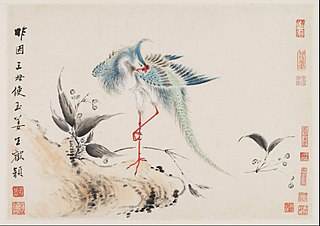 W
WHua Yan simplified Chinese: 华嵒; traditional Chinese: 華嵒; pinyin: Huà Yán; Wade–Giles: Hua Yen; courtesy name Qiu Yue (秋岳), sobriquets Xinluo Shanren (新罗山人), Dong Yuan Sheng (东园生), Buyi Sheng (布衣生), Ligou Jushi (离垢居士)and Bosha Daoren (白沙道人) was a Qing Dynasty Chinese painter. He was born in Shanghang (上杭) Fujian province and lived in Yangzhou and later in Hangzhou. Yan's work is within the tradition of the Yangzhou school and is often named as one of the Eight Eccentrics of Yangzhou.
 W
WHuang Ji, was a Chinese imperial painter during the Ming Dynasty. His birth and death years are unknown.
 W
WHuang Shen (1687–1772) was a Chinese painter during the Qing Dynasty. Huang was born in Ninghua, Fujian province, to a poor family. His courtesy names were Gongshou (恭壽) and Gongmao (恭懋). His pseudonym was Yingpiaozi (癭瓢子).
 W
WLi Zai ; ca. (unknown-1431) was a Chinese painter of landscapes and human figures during the Ming Dynasty (1368–1644). His specific birth year is not known.
 W
WLin Hejie is a Chinese painter. In February 2019, he was hired by the Fujian Provincial Government Portal to become an online commentator.
 W
WLiu Kang was a Singaporean artist known for his Balinese-themed figurative paintings. He was a founding member of the Singapore Art Society, and was credited with developing the Nanyang Style, an art style associated with the Nanyang Academy of Fine Arts. He is also the father of the architect Liu Thai Ker.
 W
WOng Schan Tchow alias Yung Len Kwui was born in the ethnically Hokkien city in the eastern part of Longyan prefecture, Southern Fujian Province, China. He was well known for Chinese Ink wash painting and colour paintings of flowers, landscapes, animals, people, still life and Calligraphy. He was regarded as one of the first few batches of Chinese scholars and artists to study in Paris and one of the few artists who integrated both traditional Chinese and Western art techniques. During the Second Sino-Japanese War, he became renowned as a patriot artist when he exhibited extensively in China, Hong Kong and later in South East Asia to raise funds solely for the war relief effort and for the countless Chinese civilian victims in China, Malaysia and Singapore.
 W
WT'ang Haywen was a Chinese-born painter who spent most of his professional life in Paris. His work is known for its fusion of the Chinese spiritual aesthetic of ink brush painting with Western abstract expressionism. His reputation has grown since his death thanks to some major retrospective exhibitions.
 W
WWu Bin was a Ming dynasty Chinese landscape painter during the reign of the Wanli Emperor. His courtesy name was "Wenzhong" and his art name "Zhiyin Toutuo" means "Mendicant monk at the temple hidden by tree branches". His specific dates of birth and death are not known. Wu was born in Putian in the Fujian province. The local relation linked him to Ōbaku Buddhism sect. He painted a large Nirvana scene painting for them.
 W
WZeng Jing ; ca. 1564 – 1647 was a Chinese painter during the Ming Dynasty (1368–1644). He was best known as a portrait painter.
 W
WZhou Wenjing, was a famed Chinese imperial painter in Ming Dynasty. His birth and death dates are unknown, but he was active until some time after 1463.